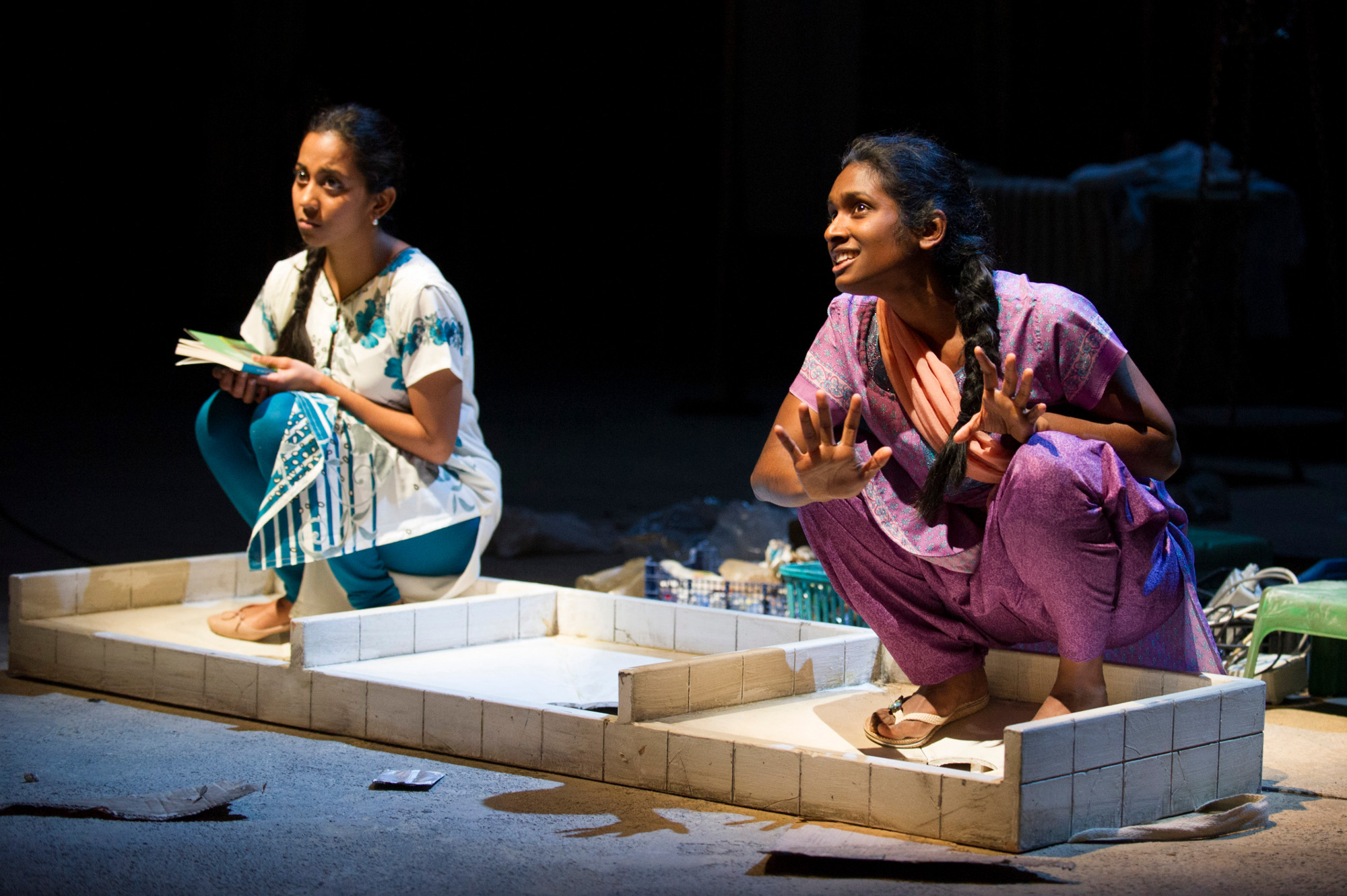BECKY BAINBRIDGE reviews ‘Behind the Beautiful Forevers’, playing at the National Theatre.
Set in the Annawadi, a ‘sumpy plug of slum’ on the wasteland fringing Mumbai airport, David Hare’s new play at the National Theatre holds no promise of being a light-hearted affair. Based on Katherine Boo’s non-fiction study of undercity life in her book ‘Behind the Beautiful Forevers’, the play conveys the very essence of an impoverished community governed by corruption.
This is a play of two halves: in the first, humour scantily excuses violence and glosses over hardship; whilst in the second, the Husain family’s struggle against injustice reveals an underlying paradox. The paradox of a deprived society dependent upon financial transaction and bribery. Under Rufus Norris’ direction the play avoids the cliché of sentimentality amidst adversity. Instead, the production evokes admiration for its characters with their individual trials contributing to an optimism founded on tenacity and hope, even in the direst of circumstances.
The conflict between the Husains and their one-legged neighbour Fatima lays the groundwork for the audience’s empathy of the lives portrayed, which are so very different from their own. Within the context of Western theatre, the problematic nature of a non-fiction book about India written by an educated, middle-class author is elucidated in visual form. The audience, like Boo in her first-hand retelling of her on the ground observations, are obliged to view this pocket of society through sympathetic eyes. At moments during the performance, there are stark reminders of the play’s basis in reality that exacerbate the piteousness of a family whose wealth is founded in the collection and sorting of rubbish. Fatima’s enflamed jealousy of the Husains’ wealth, 18-year-old Manju’s pursuit of female education, and Asha’s unsavoury means of providing for her family, culminate in an overwhelming sense of exploitation, repression and a culture dominated by ultra-violence.
Shane Zaza’s portrayal of the talented ‘sorter’ Abdul, the breadwinner of the Hussain household, adroitly conveys a character who develops a clear outlook on the morality of his actions. His epiphany emphasises the depravity of the inhumane treatment he receives due to false imprisonment. As Abdul’s mother, Meera Syal provides flashes of emotion which result from the accumulation of the family’s frustration, anger and utter despair. Zaza’s often disquietingly subtle or muted emotional state is perfectly offset by Syal’s combination of exuberant body language and intonation. Anjana Vasan as Manju holds the spotlight in quieter scenes with her fantastic comic delivery of lines tinged with irony, bringing the audience’s attention to the disparity of conditions between Annawadi and our society.
The light-relief of declaring that ‘nobody understands’ Virginia Woolf is undercut by the assertion that the Western world proclaims to be superior to poorer nations as a result of book-learning, albeit without comprehension of the literature they claim to own. The harrowing sub-plot, centred on the forbidden meetings of two girls driven to suicidal thoughts, frequently diverts the audience’s attention from the main plotline. The theme of suicide is an additional source of discomfort for an audience already overwrought with compassion in the face of unrelenting prejudice.
Punctuated by instances of remarkable collaborations between light, sound and design, the production quickly reestablishes its pace where it begins to slacken. The use of blinding white light, sound effects and projection to imitate low-flying aeroplanes is a firm reminder of the setting, and the clash of wealth existing alongside poverty. A truly breathtaking spectacle during the performance is a sudden torrent of plastic bottles onto the stage. The noise of their impact is bizarrely moving having witnessed the unremitting process of picking and sorting garbage throughout the play.
On occasion, the vastness of the Olivier stage felt a little neglected with the majority of the action transpiring within a small space at the front of the stage. By the second half however, the removal of the shanty town set creates a haunting sparseness. The great cavity of the stage swamps the little figures of the Husain family, mirroring their displacement within the community as they fall out of favour. Designer Katrina Lindsay’s utilises the space via the incorporation of scaffolding. This generates a contrast in the height at which the actors perform – an often overlooked technique – producing an optical marvel that redeems the lack of visual stimuli.
Hare’s play successfully reflects the nature of Boo’s Westernised experience of Annawadi; namely, a disturbing insight into how poverty is intertwined with corruption. Yet, the Husains’ rousing story communicates an overriding principle that remains much the same as the author’s own revelation: ‘hope is not a fiction’.
‘Behind the Beautiful Forevers’ is showing at the National Theatre until April 2015. £5 tickets are available for students through the Entry Pass scheme. Box office: 020-7452 3000. More information is available at: http://www.nationaltheatre.org.uk/shows/behind-the-beautiful-forevers
Images attributed to Richard Hubert Smith







